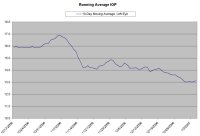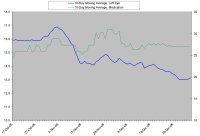A little more than 60 days ago, I wrote a blog post and asked, "Does Stress Increase My Eye Pressure?" At that time I looked back and noted that my intraocular pressure had increased as my business situation had gotten more stressful. Since then, we have collected a lot more data. I think it will prove interesting to compare two similar days and see what we can learn about stress and eye pressure given the additional data.
I will compare today's intraocular pressure data with the eye pressure data from November 2, 2006 (the day of the blog post cited above).
Today, my overall average intraocular pressure for each eye is as follows.
Left 13.0; Right 13.0 (differential 0.0)
We collected 137 intraocular pressure measurements today. Back on November 2, 2006, my overall daily averages were:
Left 18.8; Right 19.3 (differential 0.5)
We collected 78 intraocular pressure measurements that day.
The intraocular pressure values certainly seem different. A statistical test shows that the difference in intraocular pressure is indeed highly significant (p < 0.001).
I would like to speculate about why the intraocular pressure values are different. There are relatively few factors that could account for the large difference in intraocular pressure. Obviously, both sets of values belong to me. They were collected using the same methods and instruments. In addition, the weather where I live is about the same as it was 60 days ago. (The days are a bit shorter now, but if that causes any difference it would likely be toward a higher intraocular pressure.) My nutrition is the same. My residence is the same. My personal relationships are the same. Most factors are unchanged.
However, my glaucoma medication is slightly different. Back on November 2, 2006 I had used Xalatan in my left eye and Timoptic GFS 0.5% in my right eye (the previous night).
Today my medication is Xalatan in both eyes and timolol maleate 0.25% in my right eye. (And this is exactly what I used last night.)
In my experience, the timolol is highly effective for me. Based on my data, I believe it has a more powerful intraocular pressure reducing effect than Xalatan. (This is contrary to the published research, but some specialists have reported a similar superior effect with timolol for certain types of patients.) Therefore, I would not expect today's medication (with timolol that is half the strength and is not the gel-forming solution) to be significantly more effective than the medication I used the night preceding November 2, 2006.
Other than that, the only other factor in my life that is significantly different is my stress level. On and around November 2, 2006, I was engaged in some stressful financial discussions with potential partners and investors regarding a new business venture. My overall life was not highly stressful, but this one particular situation added acute stress on certain days. Right now I don't have any similar stressors in my life.
In addition, I am using a new stress reduction technique to reduce the "background stress" in my life. From my perspective, everything else in my life is the same as it was on November 2, 2006, yet my intraocular pressure is significantly lower. I wish there was a better way to ascertain the effects due to the difference in medications. Maybe there is...
When I blogged on November 2, 2006, and asked, "Does Stress Increase My Eye Pressure?", I could only look back. Now we can compare the before and after periods. During the period that included the stressful financial discussions I had higher intraocular pressure than both the preceding and the following periods.
Click here to see a full size chart of my eye pressure trend before, during and after this stressful period:
The chart shows a hump during the time period that included the stressful financial discussions. Before that my intraocular pressure was lower. After that you can see that my intraocular pressure has decreased even further. This continuing downward trend is the focus of many of my posts here in this blog. However, right now I just want to focus on the effect the stressful financial negotiations had on my intraocular pressure. Therefore, let's see if we can better understand how any medication changes related to my intraocular pressure change. For that, I'll use another chart.
Click here to see a full size chart of my eye pressure trend with medication changes:
This chart shows the same intraocular pressure trend along with a scoring system we use to quantify my medication routine. This chart shows a period of experimentation where my doctors were trying to find the right medications for me. That's why the medication score fluctuates. My doctors were watching my intraocular pressure closely with me as part of this project and adjusting my medication.
As my intraocular pressure increased (blue line) around November 2, 2006, my medication (green line) was increased in response. Clearly, the higher intraocular pressure was not due to less medication. And certainly more medication is not correlated with elevated intraocular pressure.
This particular analysis seems to point strongly to stress as the factor that increased my intraocular pressure.
However, the medication scoring system itself is somewhat subjective, so we can't draw too many conclusions from this particular chart. (Even so, the medication scoring system is consistent and it works for its intended purpose.) About the only thing I feel comfortable saying is that the chart with the medication scoring does lend further support to my hypothesis that stress increases my intraocular pressure.
If you want my current opinion, here it is: stress is the single largest factor affecting my eye pressure fluctuations on a daily basis.
To make this statement more meaningful, in future blog posts I'll try to better define stress and discuss what I'm doing to manage my stress in a way that leads to lower intraocular pressure.
Please let me know if you think stress also causes your intraocular pressure to go up.
Filed Under (tags):
- dave's blog
- Log in or register to post comments

